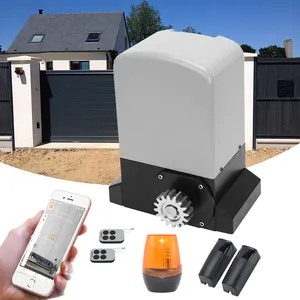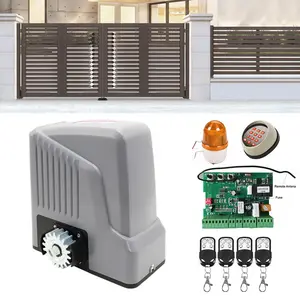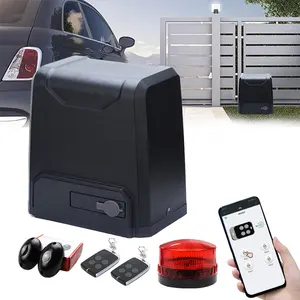
Factory Price Jujiang Heavy Duty 2000KG Electric Slide Door Motor Operator Automatic Sliding Gate Opener


WIFI Phone APP Control Electric Sliding Door System Gear Rack Kit Automatic Gate Opening Motors For Villa Courtyard Slide Gates























An electric sliding gate motor is a pivotal element in contemporary access control systems, crafted to automate the movement of sliding gates across a spectrum of properties. These motors are meticulously designed to ensure the smooth functioning of gates, bolstering security and convenience for a range of establishments including villas, hotels, offices, apartments, and beyond. The electric sliding gate motors marry robust construction with cutting-edge technology, serving the demands of both the residential and commercial realms.
The electric gate motor market offers a plethora of options, tailored to meet diverse requirements. Motors for light-duty applications suit residential properties with smaller gates and less frequent use, whereas heavy-duty motors are crafted for larger, weightier gates typical of commercial environments. Certain motors are designed for whisper-quiet operation, particularly attractive for residential settings, while others prioritize high-speed functionality, essential for maintaining traffic flow in commercial areas. The automatic sliding gate opener assortment also encompasses models that integrate seamlessly with an array of control systems, from handheld remotes and keypads to advanced smart home technologies. Moreover, these motors demonstrate resilience by functioning in harsh weather conditions, with select models featuring waterproof and dustproof designs to ensure enduring performance and dependability.
The architecture of an automatic sliding gate motor typically comprises a motor unit, a power source, a control board, and a transmission mechanism, which may involve chains, belts, or gears. The motor unit, the system's powerhouse, propels the gate's movement. The power source might be electric or solar-powered, contingent on the model. The control board acts as the operation's nerve center, facilitating the integration of various controls and safety mechanisms. The transmission mechanism is essential, converting the motor's energy into the gate's sliding motion. Additionally, many systems feature manual overrides, enabling manual gate operation during power outages, and include battery backups to guarantee functionality during power interruptions.
The materials selected for automatic sliding gate systems are chosen for their durability, strength, and environmental suitability. Common metals like steel and aluminum are favored for their robustness and resistance to degradation. Plastics are employed for components that necessitate insulation or a reduction in operational noise. Material selection often reflects the imperative to balance sturdiness with functionality, ensuring reliable motor operation across varying weather conditions and usage patterns. The incorporation of stainless steel or galvanized materials in certain parts also aids in warding off rust and corrosion, thereby prolonging the motor's lifespan.
Electric sliding gate motors are indispensable in industries where secure, regulated access is paramount. In the logistics and warehousing sector, they enable the efficient movement of goods by granting swift, controlled access to delivery vehicles. In retail environments, such as shopping centers, they bolster security by limiting access after business hours. For corporate premises, they augment the professional facade and confer a sense of prestige, while simultaneously safeguarding employees. The deployment of these motors in residential complexes adds a layer of convenience and security for inhabitants, underscoring their adaptability and significance across diverse sectors. In healthcare facilities, they are instrumental in managing access to emergency routes, ensuring ambulances can navigate without hindrance. Educational establishments also reap the benefits of heightened security and control over campus access.
The fundamental role of an electric sliding gate opener is to mechanize the gate's opening and closing actions. They are engineered to accommodate gates of varying dimensions and weights, delivering smooth and consistent performance. Sophisticated models can execute additional functions such as auto-closing after a predetermined interval, interfacing with alarm systems, and maintaining operation during power outages with the aid of battery backups. Some variants also boast adjustable speed settings, enabling gate movement at a user-preferred pace, and incorporate auto-reverse features to avert damage or injury should an obstruction be detected.
Automatic sliding gate motors are equipped with a suite of features that heighten their allure. Certain models offer silent operation, a coveted attribute for residential zones. Others provide speed regulation, facilitating rapid gate opening yet ensuring slow, safe closure. Numerous units now include built-in safety sensors that halt gate closure upon encountering obstacles, safeguarding vehicles and individuals. The integration of intelligent technology is another draw, permitting gate control via smartphone applications. Additionally, the presence of diagnostic tools within the control board simplifies troubleshooting and maintenance, rendering these motors not only technologically sophisticated but also user-friendly and easy to service.
The adoption of an electric sliding gate motor yields a multitude of advantages. For enterprises, it translates to heightened security and smoother vehicular flow, while for homeowners, it spells convenience and added peace of mind. The utilization of solar powered sliding gate openers can lead to energy conservation and a diminished environmental footprint. Collectively, these systems contribute to a more secure, efficient ingress and egress process. They also enhance the aesthetic appeal of properties with sleek designs that can be tailored to match the property's style, and can boost property value owing to the supplementary security and convenience features.
An electric sliding gate motor bolsters security by mechanizing gate operations, curtailing the need for manual intervention, which poses a security vulnerability. The motor's mechanism ensures a securely closed and locked gate, thwarting unauthorized entry. When integrated with security systems, additional functionalities such as automatic locking upon closure or alarm activation upon tampering can be realized.
In the selection of an electric sliding gate motor, factors such as the gate's weight and size, usage frequency, and power source should be taken into account. A sturdier motor is necessitated for heavy-duty or frequent usage. For remote or eco-conscious installations, a solar powered sliding gate motor may be the optimal choice. Compatibility with the existing gate infrastructure and the overall design of the gate system should also be considered. The motor's operational speed, noise emission, and safety features are crucial considerations, ensuring the motor fulfills the specific requirements and expectations of the user.
Indeed, eco-friendly alternatives such as solar powered sliding gate openers are accessible. These systems utilize solar energy to activate the gate motor, diminishing dependence on conventional electricity and lessening the carbon footprint. They are especially advantageous in regions with abundant sunlight and for property owners who prioritize sustainability without compromising on security or convenience. These solar solutions are not only environmentally considerate but also economically beneficial in the long term, as they can substantially lower the electricity costs associated with gate operation.